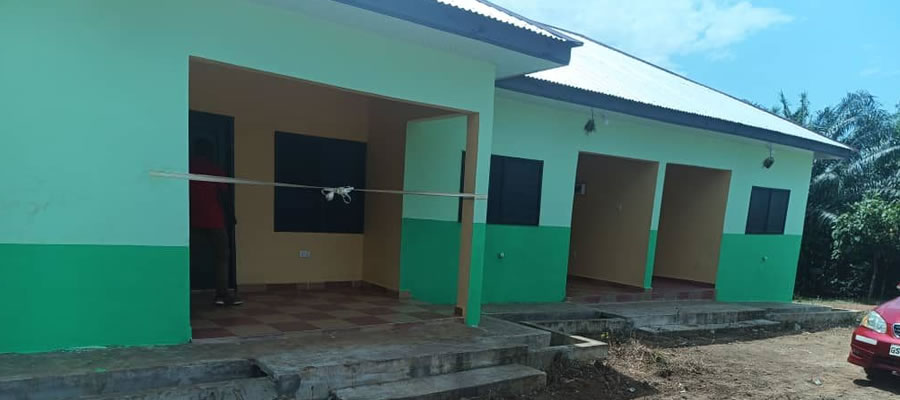

Population Size and Growth Rate
The total population of the Municipality is currently 72,810 (2010 PHC Analytical Report). Out of the total population, males constitute 49.16 percent are females 50.84 percent. The sex ratio for the municipality is 96.67, which means for every 100 females there are approximately 97 males. The current growth rate of 3.1% is higher than the national growth rate of 2.7% per annum. In order to combat poverty and provide meaningful living for the people of the Municipality, pragmatic measures should be embarked to reduce the growth rate.
Household Population by Structure and Gender
The 2010 PHC household is defined as a person or a group of persons, who lived together in the same house or compound and shared the same house-keeping arrangements. It further explained that members of a household are not necessarily related (by blood or marriage) and non-relatives (e.g. house helps) may form part of a household. There two main types of household in Ghana, namely: nuclear and extended family. There are a total of 58,750 households in the Municipality of which nuclear family constitute 51.2 percent.
Among the constituent of nuclear family, nuclear (head, spouse(s) and children) constitute the highest proportion i.e. 35.1 percent followed by single parent nuclear 10.1 percent and the lowest being head and a spouse only (2.0%).The extended family household recorded 48.8 percent while the breakdown of the extended family ranges from 14.0 percent (single parent extended) to 1.1 percent (single parent extended + non relative).The proportion of males constituting nuclear family is 52.7 percent whiles extended family is 47.3 percent, that of females nuclear is 49.8 percent and extended family for females is 50.3 percent.
Nationality by Gender
Ghanaians by birth recorded 95.4%. The proportion of Dual nationality (2.0%) is relatively low while Ghanaians by naturalization recorded 0.7%, ECOWAS (1.2%), African other than ECOWAS (0.5%) and other nationals (0.3%). Ghanaians by naturalization recorded 0.7 percent for both male and female.
Religious Composition of the Population
The people in the Municipality are highly religious. There is a dominance of Christians. Other groups include Islam and traditional religion. The 2010 Population Census revealed that the Christian group constitutes about 82.8% of the entire population of the Municipality, followed by Islam (10.9%), no religion (5.6%), others (0.5%) and traditionalist (0.3%). Christianity as the major religion makes the church a possible forum for social interaction, information dissemination and community mobilization for development
Age and Sex Composition
The sex ratio in the Municipality is predominantly high with about six age groups recording over 100% of the ratio compared with the ratio of the Municipality. The proportion of ages 10-14 recorded (100%) of the ratio with figures of 4, 647 males and 4,646 females.Statistics depicts that a larger proportion of the population lives in the rural areas. This can be attributed to the mining and farming activities in the rural areas. More than half (55.6%) of the population are rural dwellers.
Age dependency is used to study the support needed and given to young and/or old population. The municipality records a large proportion of population younger than 15 years and persons 65 and older. The Municipality’s dependency ratio is 74.2 percent. The urban setting records the highest of 77.1% of the dependency ratio compared to the ratio of the Municipality.
Economic Activities/Occupation by Gender
Skilled agriculture, forestry and fishery workers recorded the highest proportion of the employed population (46.1%), followed by service and sales workers (18.3%) and craft and related trades (11.7%). The proportion of male population engaged in skilled agriculture, forestry and fishery (49.2%) recorded higher than females (43.0%). Other occupations recorded very low percentages such as Mangers (2.0%), technicians and associate professionals (1.5%) and clerical support workers (1.1%).
Occupation Distribution
The main forms of occupations in the municipality are farming, mining and trading. Trading is mainly carried out in the urban town which is Dunkwa. Small scale mining is an activity engaged in almost all the towns within the Municipality. Most of the miners move from Dunkwa to the other towns to carry out such activities. Other migrants are also involved in the mining activities. Farming is carried out in almost all the communities with the majority carried out in the smaller towns.
Households in Agriculture
An agricultural household is defined as one in which at least one person in the household was engaged in farming/fishing/animal husbandry. According to PHC 2010, there are about 14,200 (Table 6) households in Upper Denkyira East, of which 8,480 (59.7%) are engaged in agriculture and the remaining households not into agriculture (40.30). The 2010 PHC categorises agriculture into groups, mainly: crop farming, tree growing, livestock rearing and fish farming out of the households in agriculture.
The highest proportion of farming activities households engaged is crop farming (95.6), 33.6 percent are into livestock rearing, tree planting 0.5 percent while the lowest being fish farming is 0.2 percent. A little above 34 percent of households in agriculture are in urban areas whiles 82.7 percent are rural areas. About 98.1 percent of agriculture households in rural areas are engaged in crop farming, 36.3 percent into livestock rearing, 0.5 percent into tree planting and the least into fish farming (0.2%). Urban households engaged in agriculture follows the same pattern as rural households engaged in agriculture.
Migration Trends
The migration trends in the Municipality are basically movement from Dunkwa to the smaller communities for small scale mining. However, during weekly market days, traders and farmers migrate from their various communities to Dunkwa to trade. Also, traders travel from neighbouring towns to trade in Dunkwa.
Economy/Agricultural Activities
The Economy of the Municipality can be classified as mainly agrarian. The good nature of the vegetation found in the Municipality encourages and promotes agricultural activities thus helping to generate income from farming activities. About 60% of the working population engages in vibrant farming while 15% engage in small scale mining and 10% could be found in trading and other varied economic activities.Crops such as Cocoa, oil palm, pineapple, plantain, cassava and corn are cultivated in the municipality with cocoa being the major cash crop grown in the Municipality.The Municipality is also endowed with valuable timber species such as mahogany and Wawa.
Although the timber industry provides venture for income generation, the logging activities occur in both in and off reserves thus having a negative impact on the rainfall pattern of the Municipality.There are light industries such as mineral water production and sawmills. Small scale mining also contributes to the socio-economic development of the Municipality. Most of the male youth derive their livelihood from mining of mineral deposits in the Municipality. These include gold, gravel, sand, clay, kaolin and silica.Over the past two years, the Municipality has generated an amount of GH¢741,217.66 internally. Internally, the Municipality has generated an average amount of GH¢370,608.83 annually over the past two years.
The River Offin and the Forest Reserve belt are the major tourist attraction areas in the Municipality. However these sites have not been developed to attract tourist and as a result, not much revenue is generated from these due to the low patronage. There is therefore the need to invest in these especially the forest reserve so as to attract tourist into the Municipality.The Municipality can boast of a total length of 190km of laterite and bitumen roads however, most of the trunk roads are in poor conditions thus making transportation difficult especially during rainy season. This has invariably affected the conveyance of foodstuffs from the growing centers to the markets.
Date Created : 11/24/2017 6:56:45 AM








 facebook
facebook
 twitter
twitter
 Youtube
Youtube
 +233 593 831 280
+233 593 831 280 0800 430 430
0800 430 430 GPS: GE-231-4383
GPS: GE-231-4383 info@ghanadistricts.com
info@ghanadistricts.com Box GP1044, Accra, Ghana
Box GP1044, Accra, Ghana